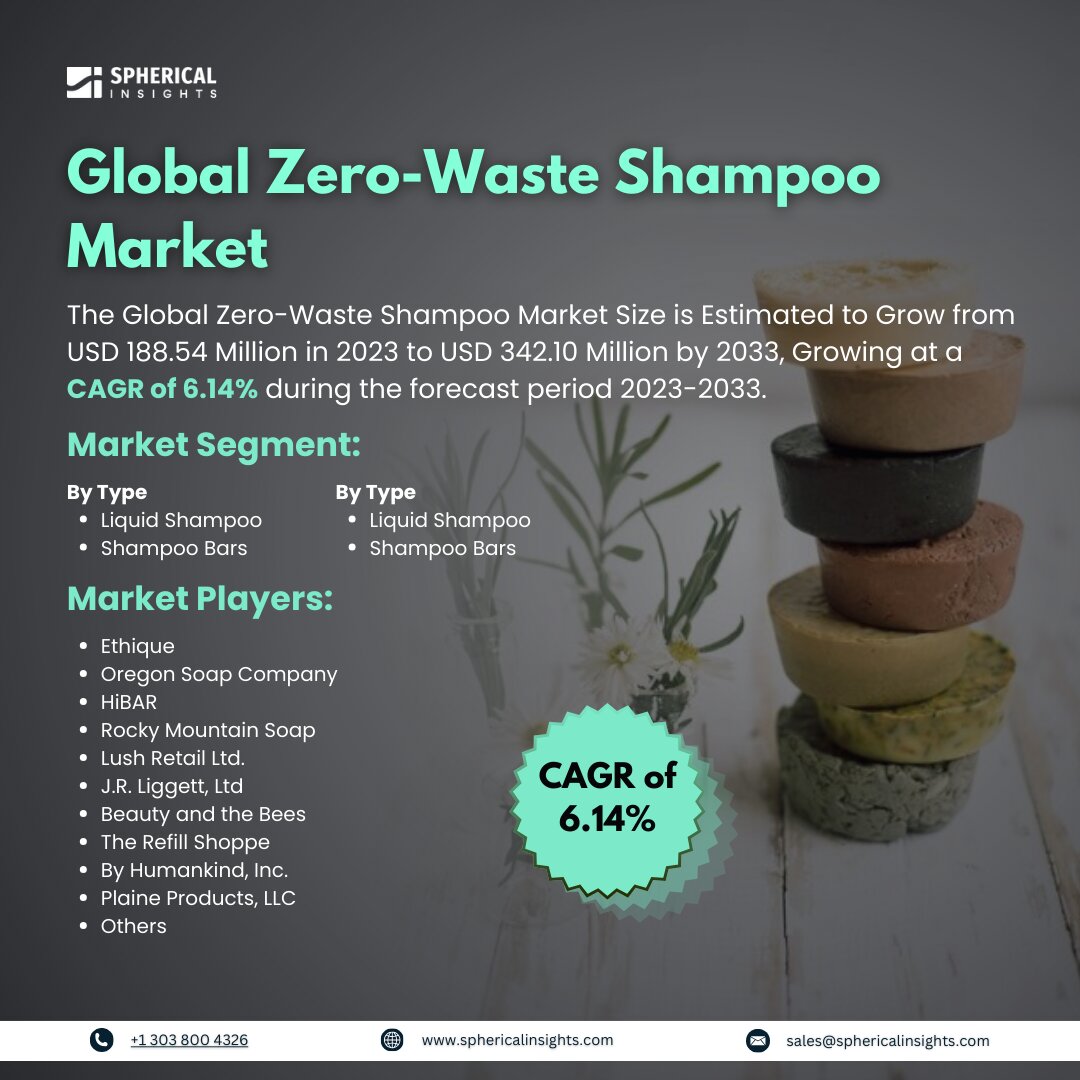Global Zero-Waste Shampoo Market Size to Worth USD 342.10 Million by 2033
According to a research report published by Spherical Insights & Consulting, the Global Zero-Waste Shampoo Market Size is Estimated to Grow from USD 188.54 Million in 2023 to USD 342.10 Million by 2033, Growing at a CAGR of 6.14% during the forecast period 2023-2033.
Browse key industry insights spread across 215 pages with 110 Market data tables and figures & charts from the report on the Global Zero-Waste Shampoo Market Size, Share, and COVID-19 Impact Analysis, By Type (Liquid Shampoo and Shampoo Bars), By End-user (Residential Consumers, Salons and Spas, and Others), By Distribution Channel (Supermarkets & Hypermarkets, Specialty Stores, Online, and Others), and By Region (North America, Europe, Asia-Pacific, Latin America, Middle East, and Africa), Analysis and Forecast 2023 – 2033.
Zero-waste shampoo is a formulation and packaging strategy designed to reduce the product's environmental effect across its whole lifecycle. Customers' increased ecological concerns mostly drive the demand for zero-waste shampoo. The shift toward sustainable alternatives has been encouraged by growing awareness of the negative effects of plastic pollution, especially from products for personal use. Customers are looking for products that are more in line with their environmentally conscious beliefs, and zero-waste shampoos provide a useful way to cut down on plastic waste. Additionally, consumers' desire to live a better lifestyle has increased demand for natural and organic personal care products since they believe these goods to be less damaging to both the environment and their bodies. Government laws and programs that address plastic pollution have had a big impact on the market's expansion. Additionally, the accessibility and reach of the industry have been increased due to the large selection of zero-waste products available on e-commerce platforms, which has further fueled market expansion. In addition, the zero-waste shampoo market is driven by a high focus on product innovation and development. Businesses are spending a lot of money on R&D to create shampoo compositions that are effective, aesthetically pleasing, and low in waste. Customers have increased as a result of the emphasis on using natural ingredients, providing a range of products, and offering easy packaging alternatives. However, the high cost of zero-waste shampoo products is one important factor that is anticipated to limit the market's revenue growth.
The shampoo bars segment accounted for the largest market share of 70.2 % in 2023 and is expected to grow at a significant CAGR during the forecast period.
Based on the type, the zero-waste shampoo market is categorized into liquid shampoo and shampoo bars. Among these, the shampoo bars segment accounted largest market share of 70.2 % in 2023 and is expected to grow at a significant CAGR during the forecast period. Primarily attributed to customers' growing environmental awareness and desire to reduce their use of plastic. Since shampoo bars do not require plastic bottles, they provide a useful option that is consistent with the zero-waste attitude. Additionally, because the shampoo bars are small and lightweight, they are perfect for outdoor activities and travel, which increases their customer appeal. Another factor in the expansion has been the belief that shampoo bars are more cost-effective and concentrated than liquid shampoo.
The salon and spas segment is anticipated to hold a significant market share of the global zero-waste shampoo market through the projected period.
Based on the end-user, the zero-waste shampoo market is classified into residential consumers, salons and spas, and others. Among these, the salon and spas segment is anticipated to hold a significant market share of the global zero-waste shampoo market through the projected period. Salons and spas are implementing zero-waste shampoos in response to client demand as a result of growing environmental consciousness and a shift towards sustainable beauty products.
The supermarkets & hypermarkets segment is estimated to hold the highest market share of the global zero-waste shampoo market and is expected to grow at a significant CAGR through the forecast period.
Based on the distribution channel, the zero-waste shampoo market is divided into supermarkets & hypermarkets, specialty stores, online, and others. Among these, the supermarkets & hypermarkets segment is estimated to hold the highest market share of the global zero-waste shampoo market and is expected to grow at a significant CAGR through the forecast period. A wide range of consumers were able to quickly access zero-waste products due to the broad availability of these retail formats in various geographic locations. The established brand awareness and trust of supermarkets and hypermarkets also affected consumer purchase decisions. Sales were also boosted by the addition of zero-waste shampoos to these retailers' product lines, which matched the growing consumer preference for eco-friendly and sustainable solutions.
North America is expected to hold the largest share of the zero-waste shampoo market through the forecast period.
North America is expected to hold the largest share of the zero-waste shampoo market through the forecast period. The sector is rising rapidly in North America due to several factors, including higher consumer awareness of environmental issues, stricter laws governing plastic waste, and a greater emphasis on natural and organic components in wellness culture. Additionally, the region's well-established e-commerce infrastructure and early adoption of sustainable living practices have had a significant impact on the market's expansion. Innovative product formulations and packaging options that appeal to the preferences of North American consumers strengthen the market's dominance in the region.
Asia Pacific is predicted to grow at the fastest CAGR of the zero-waste shampoo market over the forecast period. There is a growing demand for eco-friendly items due to the growing upper-middle class, which has more purchasing power and is more concerned about the environment. Social media's increasing use enhances the impact of sustainability, and the region's young, tech-savvy population is responsive to eco-friendly methods. Zero-waste shampoos are also becoming more popular as a result of changing lifestyles and fast urbanization, which is driving the trend for time-saving and easy personal care products. A favorable regulatory environment for the market's expansion is also created by government initiatives to promote sustainability and reduce plastic waste.
Competitive Analysis
Major key players in the zero-waste shampoo market include Ethique, Oregon Soap Company, HiBAR, Rocky Mountain Soap., Lush Retail Ltd., J.R. Liggett, Ltd, Beauty and the Bees, The Refill Shoppe, By Humankind, Inc., Plaine Products, LLC, and others.
Recent Developments
- In January 2024, Kao Corporation introduced "Melt," a new hair care line that provides beauty care for moments of relaxation. This brand is a part of Kao's transformation to become a growth driver for its hair care business.
Key Target Audience
- Market Players
- Investors
- End-users
- Government Authorities
- Consulting And Research Firm
- Venture capitalists
- Value-Added Resellers (VARs)
Market Segment
This study forecasts revenue at global, regional, and country levels from 2023 to 2033. Spherical Insights has segmented the zero-waste shampoo market based on the below-mentioned segments:
Global Zero-Waste Shampoo Market, By Type
- Liquid Shampoo
- Shampoo Bars
Global Zero-Waste Shampoo Market, By End-user
- Residential Consumers
- Salons and Spas
- Others
Global Zero-Waste Shampoo Market, By Distribution Channel
- Supermarkets & Hypermarkets
- Specialty Stores
- Online
- Others
Global Zero-Waste Shampoo Market, By Regional Analysis
- North America
- Europe
- Germany
- UK
- France
- Italy
- Spain
- Russia
- Rest of Europe
- Asia Pacific
- China
- Japan
- India
- South Korea
- Australia
- Rest of Asia Pacific
- South America
- Brazil
- Argentina
- Rest of South America
- Middle East & Africa
- UAE
- Saudi Arabia
- Qatar
- South Africa
- Rest of the Middle East & Africa



